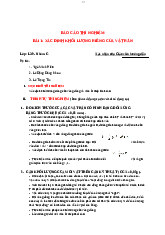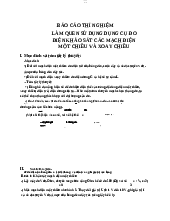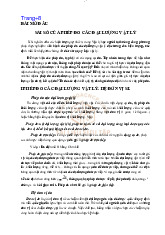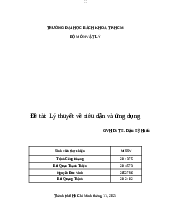












Preview text:
lOMoARcPSD|46958826 lOMoARcPSD|46958826
HO CHI MINH CITY – UNIVERSITY OF TECHNOLOGY LAB 4 REPORT THERMOCOUPLE
DETERMINATION OF THE THERMOCOUPLE CONSTANT
Instructor: Dr. Tran Anh Tu
Subject: General Physics Labs Class: CC11-Group 6
School year: 2021-2022 - Semester 2 GROUP 1 MEMBERS
Students’ names ID code Lecturer’s comment 1. 2. 3. 4. 5. I/ OBJECTIVE lOMoARcPSD|46958826
Ho Chi Minh City University of Technology General Physics Labs
To get used to thermocouple (chromel-alumel), MC-897 electronic
millivoltmeter to determine the thermocouple constant. II/ THEORY
A thermocouple is a closed electric circuit
consisting of two dissimilar conductors A and B
that are joined together (Figure 1). If junctions 1
and 2 are at different temperatures T1 and T2
(T1>T2), respectively, an electric current that is
called thermoelectric current is produced within the circuit.
Electromotive force that generates the
thermoelectric current is known as thermal electromotive force E.
Thermal electromotive force is yielded because
free electrons diffuse from the metal with a higher density of free electrons
to the metal with a lower density at junctions 1 and 2. Theories and
experiments have proved that the magnitude of thermal electromotive force
depends on the nature of the two metals and the temperature difference
between the two junctions of the thermocouple. Within a certain
temperature range (depending on thermocouple types), thermal
electromotive force E increases proportionally to the temperature difference
(T1 - T2) between the two junctions as denoted in Equation 1:
Enđ = C.(T1 - T2 ) (1)
where C is the thermocouple constant. For metal thermocouples, the value of E
is small; therefore, C is measured in the unit of either or . Thermocouples can
be used as a thermometer to measure temperature or a low-power electric
source (obtained by converting thermal energy to electric energy).
Prior the use of a thermocouple, we have to sample
the thermocouple; that is, we have to investigate the
temperature range (depending on the thermocouple
type) where thermal electromotive force is linearly
dependent on the temperature difference (T1 - T2) Page 1 Group 1’s Report lOMoARcPSD|46958826
Ho Chi Minh City University of Technology General Physics Labs
between its two junctions. As a result, the graph
representing the function of E = C.(T1 - T2 ) is a
segment (Figure 2), and constant C is calculated as in Equation 2: C= = tga (2)
Since resistance RV of millivoltmeter mV is much
larger than internal resistance r of the thermocouple,
applying Ohm’s law to a closed circuit, we have:
E = I .(RV + r ) ≈ I .RV = UV (3)
where I is the current intensity, Uv is the reading on millivoltmeter mV.
Thus, for every value of temperature difference (T1 - T2) between the hot
junction (T1) and the cold junction (T2) of the thermocouple, we measure the
corresponding value of thermal electromotive force E on millivoltmeter mV.
Therefore, we can draw the graph representing thermocouple sampling and
determine the value of constant C. Page 2 Group 1’s Report lOMoARcPSD|46958826
Ho Chi Minh City University of Technology General Physics Labs III/ APPARATUS
1. Thermocouple (chromel-alumel); 2. Thermocouple holder;
3. MC-897 electronic millivoltmeter;
4. Two 250ml experiment glasses; 5.Digital thermometer(-500C 1500C); 6. Wine thermometer (0 1000C); 7. Boiler (220V - 300W);
8. Digital multimeter 3,1/2 Digits 9. Set of wires. IV/ PROCEDURE Step 1
Connect the wires to form the electric circuit as demonstrated in Figure 3. Set
the range selector knob of millivoltmeter mV at position 15. Set the digital
multimeter at the measurement range of 200mVDC. Use a piece of wire to short
circuit the positive and negative probes. Turn sensitivity knob R
counterclockwise all the way left.
Plug digital millivoltmeter mV in the mains of 220V. Press button K on the
front and millivoltmeter mV starts. Wait for 4 ÷ 5 minutes, then perform zeroing
the measurement range of millivoltmeter mV by turning slowly the zero
corrector to move the pointer to 0, and the digital multimeter also displays 0.
Then, the maximum value of the measurement range on the millivoltmeter mV
is equal to 15mV. Turn knob "0" until the reading is 5mV on the electronic
millivoltmeter, then read the value of Ukđ on the digital multimeter to derive the
amplification coefficient k = Ukđ /5mV. Afterward, repeat zeroing for
millivoltmeter mV, disconnect the wire from the positive and negative probes
and connect it to the thermocouple. Step 2
Place the bulbs of thermometers 3 and 4 at the same level as the junctions of
thermocouples 1 and 2 in the middle of boiler 5 and experimental glass 6,
respectively. Wait for 4÷5 minutes, then read and record the reading of
temperature T1 on thermometer 3 and that of temperature T2 on thermometer 4
in Table 1. If T1 is equal to T2, the pointer of millivoltmeter mV must point at 0. Step 3 Page 3 Group 1’s Report lOMoARcPSD|46958826
Ho Chi Minh City University of Technology General Physics Labs
Plug the boiler 5 in the mains of 220V. Wait until the water in the boiler begins
to boil, then unplug the boiler 5 and let the water in the boiler cool down (avoid a quick cool down).
For every value of T1, record the reading of Ukđi on the digital multimeter to
calculate thermal electromotive force Enđ and write it down in Table 1. Repeat
this process until temperature T1 decreases to 40°C.
Note: When the range selector "RANGE" of millivoltmeter mV is set at X10
and sensitivity knob R is turned all the way left, the maximum limit on
millivoltmeter mV is 15mV. Step 4
Read and record the following data in Table 1: a.
The level of accuracy δv and the maximum value Um on the measurement
range of electronic millivoltmeter mV. b.
The level of accuracy δv and the maximum value Um on the measurement
range of digital millivoltmeter mV. c.
Accuracy ΔT of thermometers 3 and 4. V/ EQUATIONS
1. Determine amplification factor k and relative error
2. Calculate absolute error and
3. Determine thermodynamic capacity at measurement and the
corresponding relative error
4. Calculate absolute error at measurement
5. Calculate absolute error Page 4 Group 1’s Report lOMoARcPSD|46958826
Ho Chi Minh City University of Technology General Physics Labs
6. Calculate the average and absolute error where = C.( - ) VI/ EXPERIMENTAL DATA Table 1
- Electronic millivoltmeter mV: δν = 1.5% ; Um =15 (mV)
- Digital millivoltmeter mV: δν = 0.5% ; n =3, a = 0.1 (mV) - Digital thermometer: ΔT =0.3 (°C) Measurement T1 T1– T2 Δ(T1 – Ukđ (mV) Enđ (mV) ΔEnđ / (°C) T2) T2 =28 (0C) 1 95 67 0.6 150.6 5.02 2 90 62 0.6 132.4 4.41 3 85 57 0.6 119.3 3.98 4 80 52 0.6 105.2 3.51 5 75 47 0.6 96.2 3.21 6 70 42 0.6 84.7 2.82 7 65 37 0.6 74.9 2.50 8 60 32 0.6 67.7 2.26 0.1386 9 55 27 0.6 58.4 1.95 0.1209 1 50 22 0.6 48.1 1.60 0.1014 0 1 45 17 0.6 39.8 1.33 0.0856 1 VII/ CALCULATIONS
1. Calculate values and errors: Calculate k and errors:
Calculate at measurement Page 5 Group 1’s Report lOMoARcPSD|46958826
Ho Chi Minh City University of Technology General Physics Labs ) ) ) ) )
Calculate the corresponding absolute error at measurement Page 6 Group 1’s Report lOMoARcPSD|46958826
Ho Chi Minh City University of Technology General Physics Labs
2. Plot the graph of Enđ = C.(T1 – T2) on a millimeter paper
Scale: horizontal axis: 5°C/cm; vertical axis: 0,5 mV/cm Page 7 Group 1’s Report lOMoARcPSD|46958826
Ho Chi Minh City University of Technology General Physics Labs
3. Determination of the thermocouple constant 3.1 Method 1
In the working range of temperature, let the graph representing the function be
segment OA. Then, the average and the absolute error of constant C are calculated as follows: where = C.( - )
or ξnđi is a point on the line corresponding to (T1i – T2).
Calculate the average and absolute error ● Page 8 Group 1’s Report lOMoARcPSD|46958826
Ho Chi Minh City University of Technology General Physics Labs =1563.5527 ⇒ ● Page 9 Group 1’s Report lOMoARcPSD|46958826
Ho Chi Minh City University of Technology General Physics Labs ● ==0.0848 ==0,0014 ==0,0021 ==0,0267 ==0,0121 ==0.0198 ==0,0131 ==0,0000031 =0,0016 ==0,0025 ==0,016 ● Page 10 Group 1’s Report lOMoARcPSD|46958826
Ho Chi Minh City University of Technology General Physics Labs Page 11 Group 1’s Report lOMoARcPSD|46958826
Ho Chi Minh City University of Technology General Physics Labs 3.2 Method 2 a. Calculation of C
Let α be the tilt angle of segment OA with respect to the horizontal axis, we have:
b. Calculation of error ΔC (Review item IV
of the lecture "How to determine the error of the
measurement of physical quantities"
Applying differential, we obtain:
Since C 2 = tg 2α << 1, we deduce equation 4: (4)
Here, we can consider Δα the angle between two lines starting from origin O and
going through the two endpoints of the error segment 2ΔE. Δα is
approximated as denoted in equation 5: (5) and
Thus, according to equation 4, we obtain: VIII/ CONCLUSION Method 1: Method 2: Page 12 roup 1’s Report



